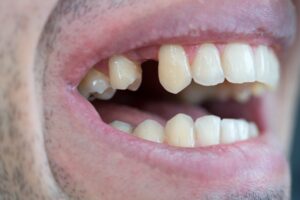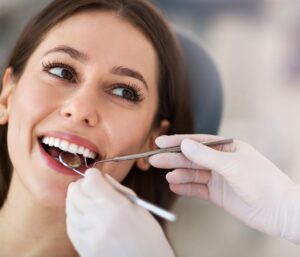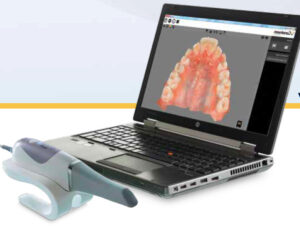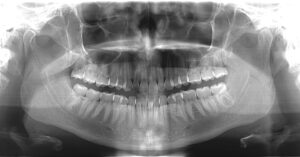Header logo
header top contact widget
Tooth Replacement
The “Risk vs. Reward” of Oral Health
Posted on Jun 25, 2024 by William J. Claiborne, DDS MS
Risk versus reward.
This is a phrase that’s often associated with decision-making, such as stock market investments. While certain strategies can increase the potential for “reward,” there is still an element of “risk” in losing part or all of the investment.
As a periodontist in Asheville, I see this in how it relates to decisions in dentistry. This is the case in replacing lost teeth. As a periodontal specialist, I place many dental implants in patients who’ve lost teeth that likely could have been kept had the patient made different decisions.
I also see this is in the decision of patients to have a crown (“cap”) placed on teeth. When a dentist recommends a crown, it is typically to keep the existing tooth structure intact and protected. So, when a tooth that’s been filled and needs yet another filling, the dentist may advise crowning the tooth instead. This preserves the remaining structure by avoiding the “risk” of tooth from breaking off.
Or, when a tooth shows signs of fracture(s), crowning may prevent the tooth from the need for removal. This is because a tooth that eventually breaks below the gum line can no longer be saved. Once removed, tooth replacement brings on an entirely new set of decisions, and costs.
Your general dentist’s goal, like yours, is to help you achieve and maintain a healthy smile. He or she wants you to keep your natural teeth or, if tooth loss does occur, replace them in a way that supports your overall oral health. A periodontist can be a strong team player in this goal.
A periodontist is a dentist who specializes in the prevention, diagnosis, and treatment of periodontal disease and in the placement of dental implants. A periodontist is also a specialist in reshaping gum tissues, for reasons that may include esthetics as well as maintaining oral wellness.
I place many dental implants and am a proponent of them as a superior tooth replacement option. However, as ideal as an implant is, there is nothing as good for your oral health as natural teeth. This is why it’s so important to keep them. This may, for certain teeth, require the placement of a crown.
A periodontist may be involved in certain aspects of treatment to optimize a patient’s results and success level while minimizing discomfort. For instance, a periodontist may work with your general dentist to help save a tooth from removal when a tooth has broken close to the gum line. This is accomplished through crown lengthening procedures where gum tissues are removed to expose more of the tooth. This may be able to make sufficient tooth structure available to support a crown.
Crown lengthening is also beneficial in sealing gum tissues surrounding a tooth at its base. By securing the tissue around the tooth or crown, bacterial entry is avoided and the risk for periodontal (gum) disease decreased. This is especially beneficial in cases where gum tissues have receded, exposing sensitive tooth root sections that are easily affected by oral bacteria.
In some cases, gum tissue height can be corrected by careful removal in a procedure known as a gingivectomy. To enhance the appearance of a smile with an esthetically-pleasing smile line, combined with the placement of crowns, the tooth-to-gum ratio is rebalanced.
This is what is often referred to as a “gummy smile.” Crown lengthening is a common method that teams your general dentist with a periodontist to create a smile that looks natural and is beautifully flattering.
Another look at the risk-reward consideration, the “risk” of not caring properly for oral health can easily upend the “reward” of having a healthy smile. Regular dental check-ups and a thorough at-home oral hygiene regimen can prevent the development of cavities and periodontal disease.
When oral bacteria levels in the mouth are not managed, the teeth and gums pay the price, often through the need for costly treatment that may have been prevented. Periodontal disease is the nation’s leading cause of adult tooth loss.
Research has also found that the inflammatory bacteria of gum disease can enter the bloodstream, triggering or worsening a long list of serious health problems. These include heart disease, stroke, high blood pressure, diabetes, arthritis, memory loss, some cancers, impotency and Alzheimer’s disease.
Although gum disease can exist without obvious signs or symptoms, the most commonly noticed are:
• Red, swollen or tender gums
• Seeing blood in the sink when brushing
• Receded gums
• Loose or separating teeth
• Pus pockets on gum tissues
• Sores in the mouth
• Persistent bad breath
As a periodontist in Asheville, we want everyone to know the benefits of a healthy, confident smile. Maintaining healthy gums and keeping your natural teeth is important to every individual.
If your gum health needs improvement or there are signs of gum disease, we can structure a program that restores healthy gums and helps you maintain your oral health between visits.
For those who have already experienced tooth loss, we are happy to discuss the process to replace them with dental implants. These are the closest thing to the natural teeth you had and will restore stability and dependable biting and chewing. Too, dental implants are designed to last a lifetime, making them an excellent investment.
With proper measures, you can enjoy healthy gums and natural teeth throughout your lifetime. Call 828-274-9440 to schedule a periodontal examination or ask for a consultation to get to know us. A referral to our office is not required.
If dental fear or anxiety has kept you from receiving regular dental care, please ask us about oral or I.V. sedation (“twilight sleep”). Both are administered safely with patient comfort always a priority.
Dental Implants Gaining Ground In Tooth Replacement Preferences
Posted on Jun 20, 2024 by William J. Claiborne, DDS MS
For adults who have lost natural teeth, I have good news and bad news. Let’s get the bad news out of the way first…
Missing natural teeth, whether replaced by a full denture, partial denture, bridge, or not being replaced at all, can lead to problems that impact your oral health, even the lifespan of remaining natural teeth. I’ll address those problems further on, but let’s move on to some good news.
According to the National Institutes of Health & Nutrition Examination, by 2026 nearly 23% of adults are estimated to opt for dental implants as their choice to replace teeth.
https://www.ncbi.nlm.nih.gov/pmc/articles/PMC6854267/
This is great news for our rapidly aging population. Dental implants come with a number of advantages that effect overall health. These include:
• The ability to bite and chew food thoroughly, aiding digestion. It has been found that people who wear dentures take more medications and have more gastro-intestinal problems.
• Eating comfort so a diet of fibrous and healthy food choices can provide sufficient vitamins, minerals and protein.
• Confidence in social situations, which (according to an article by the Mayo Clinic News Report): “Socializing not only staves off feelings of loneliness, but also it helps sharpen memory and cognitive skills, increases your sense of happiness and well-being, and may even help you live longer.”
• Helping to support remaining natural teeth by preserving jaw bone mass. When a tooth root is removed from the jaw bone where it was once supported, a process known as resorption begins. Once underway, it continues at an ever-increasing pace, accelerating with each passing year. As the bone shrinks, adjacent teeth are subject to movement and root damage. On average, the next teeth you’ll most likely lose are those bordering areas of missing teeth.
Since the mid to late-60’s, dental implants have been fine-tuned and perfected. Today, there are nearly 40 different types of dental implants. These systems are designed to accommodate specific needs and goals.
For instance, using just 4 or 6 implants placed at unique angles, the All on 4 Dental Implant system is able to evenly distribute the forces of biting and chewing in minimal bone. This is ideal for people who have experienced severe bone loss, helping them avoid the need for bone rebuilding procedures.
With all the great reasons to replace missing teeth with dental implants, an important decision in having a successful outcome is in who places your implants.
Although some generalists take courses in dental implant placement, many of these are offered by the manufacturers of particular implant systems. Thus, these courses primarily focus on the implant available through this one company, which may not be the most ideal choice for your specific needs.
This is why many dentists refer the placement portion of implants to a periodontal specialist. A periodontist has advanced training and skills in the diagnosis and placement of all types of dental implants. This means that this dental specialist can determine which implant system will work best for your individual needs.
Another benefit of a periodontist’s skills for implant patients is in their ability to conduct additional procedures, such as a sinus lift, needed in treatment. This ensures the patient’s implant(s) are positioned in the proper bone mass at a healthy depth so it does not pose risks to surrounding structures.
As a specialist in treating all stages of gum disease, a periodontist is also able to help optimize your gum health prior to implant placement. By pretreating any periodontal inflammation, the implant has a healthy foundation from the very beginning.
In our Western NC periodontal dental office, we incorporate the advantages of some of the most advanced technology in dentistry; many of these options which are not readily available in other dental offices in our region. These computerized marvels offer advantages to patients in helping to minimize treatment needs, speed healing, and optimize comfort.
These include laser dentistry, Cone Beam imaging, Cone Beam computerized tomography imaging, intraoral scanning, and computerized dental implant placement.
Additionally, in our Asheville periodontal dental office, we offer oral and IV sedation (“twilight sleep”) for optimal comfort. Both have an amnesiac effect, leaving most with little or no memory of treatment afterward. Here, anesthesia is overseen by a Medical Doctor (MD) who is a board certified Anesthesiologist. With both sedation options, patients are closely monitored with advanced safety equipment throughout treatment.
If you’ve considered dental implants, take the first step to a new you today! Begin by calling our Asheville periodontal dental office to speak with a friendly staff member at: 828-274-9440.
If the cost of dental implants has prevented you from choosing this optimal tooth replacement option, most of our payment plans require no down payment, are interest-free, and have no prepayment penalty. Feel free to ask about those during a consultation.
Know How Summer Comes With Oral Health Risks
Posted on May 20, 2024 by William J. Claiborne, DDS MS
As an Asheville periodontist, there are two times a year I feel come with higher risks for keeping one’s oral health well-maintained.
One is during the Thanksgiving-Christmas season. During these times, people tend to consume food and beverages that are higher in carbs and simple sugars. And, they eat more frequently. I understand – it’s pretty hard not to sneak a piece of grandma’s fudge with a mid-morning cup of coffee!
Although the hardships to teeth and gums brought on by these indulgences may be diluted by swishing or an extra brushing during the day, summertime has its own set of challenges that are rather similar.
First, understand that any time you eat or drink something (other than plain water), an acid attack begins in the mouth. This acid flows in with saliva, bringing in an acid to break down food as its chewing; the body’s first stage of digestion. These acids are rather potent in that they can even soften enamel for 20-30 mins. Thus, when other acidic elements are introduced in the mouth, the higher levels of acid can leave precious tooth enamel at risk.
Below are things to keep in mind as we go into the official “it’s okay to wear white” season!
Oral acidity – Summer foods and beverages seem to come with a wealth of consumables that are high in acidity – garden fresh tomatoes, lemonade, water or tea with a squeeze of lemon, etc. Just know that they need to be diluted by swishing with water or drinking gulps of water while consuming.
Colas – I can’t say enough bad things about colas when it comes to oral health. While sodas, coffee, tea and wine are all highly acidic, the acidity levels in colas have been compared to nearly that of the levels in battery acid. Colas are highly acidic because they are infused with phosphoric acid, intended to add flavor. Phosphoric acid is so erosive it can remove rust from aircraft carriers and ships.
When these erosive acids are mixed with the acids that occur naturally in the mouth, there is a significantly higher potential to erode tooth enamel. Dental erosion can cause temperature sensitivity, pain, transparent teeth, cracking and darkening of teeth.
Also concerning is the way colas are consumed. Every time you sip a soda, an acid attack in the mouth is triggered for 20-30 minutes until eating or drinking ceases. Because colas are typically consumed slowly over long periods of time, the acid attack lasts that long plus another 30 minutes before subsiding. For colas containing sugar, this mixes with the acid in the drink and your digestive acids for an even greater level of destruction.
Accidents & injuries to the mouth – Outdoor sports and activities such as skiing, biking and baseball should all be done with a custom-made mouthguard in place. This is important for children and adults. Having a permanent tooth knocked out can be devastating.
If the worst should happen, a periodontist is your specialist in placing dental implants. And, by acting soon after the tooth is lost, you can preserve the natural contours of the gum tissues that arch the tooth. These arches of gums help to create a natural appearance when the replacement tooth is placed along with the “points” that dip slightly between each tooth.
A periodontist has advanced skills in the diagnosis and placement of the implant type best for individual needs. In our Asheville periodontal dental office, we use advanced imaging and implant guidance technology that helps to minimize treatment and optimize comfort with reduced healing time.
Oral Dryness – “Dry mouth” promotes oral bacteria by enabling rapid reproduction. When oral bacteria are able to linger in the mouth, they have an ideal warm, dark, moist environment. Without saliva serving as a continual rinsing agent to keep bacteria levels in the mouth under control, oral bacteria accumulate at a rapid pace.
Water intake helps to support saliva in the mouth to rinse bacteria and food particles from the mouth. Sufficient saliva flow helps in neutralizing the acids produced by oral bacteria and aids in preventing tooth decay and the development of periodontal (gum) disease.
By understanding where the risks lie, you can take proactive measures between visits to prevent things like cavities and gum disease.
An overload of oral bacteria initially reveals itself as plaque, at first. This is a sticky film that coats the teeth and gums, which is easily noticeable upon waking up. If not thoroughly removed each day, it can hardened at the base of teeth. This is known as tartar.
Tartar is a cement-hard colony of bacteria, which feed on tender gum tissues. This can cause tender gums that bleed easily when brushing and more frequent bad breath.
This early stage of gum disease is known as gingivitis. If not resolved quickly, it can easily progress. Periodontal disease is an inflammation of the gum tissues that causes bleeding, swelling, persistent bad breath and gum recession. As it worsens, gum disease can enter the advanced stage of periodontitis. In this, infectious oral bacteria attack the area below the gum line, including bone and tissues that support natural teeth.
The bacteria can also enter the bloodstream through tears in diseased gums. The inflammatory nature of this bacteria can trigger a number of serious health problems, including heart disease, stroke, some cancers, diabetes, arthritis, pre-term babies and more. Periodontal disease is also the nation’s leading cause of adult tooth loss.
Summer is a wonderful time for vacations and being more active outdoors. However, don’t let your daily oral care regimen result in costly repairs down the road. Avoid taking “time off” from your twice-a-day oral hygiene routine so bacterial growth doesn’t require dental treatment as a result.
When vacationing, some tips for your oral upkeep include:
• When packing, place your tooth brush, floss and toothpaste in one container separate from other items. Once you arrive at your destination, place this by the sink so they are handy each morning and evening.
• Take along sugarless gum to help you maintain sufficient saliva flow in the mouth. This aids in removing bacteria before it builds into the stick film that forms plaque.
• Brush at least 2 minutes per brushing followed by brushing your tongue to dislodge embedded bacteria.
• If you can’t brush right after a meal, swish with water or chew sugarless gum.
• Drink lots of water throughout the day to keep oral tissues moist.
Call 828-274-9440 if you have questions about your gums or if you are experiencing symptoms of gum disease. This disease will only worsen without treatment. You may also wish to begin with a consultation.
You are invited to visit our website to learn more about dental implants, sedation options (including “twilight sleep”) and advanced technology.
What Can A Periodontist Do For You?
Posted on May 13, 2024 by William J. Claiborne, DDS MS
In meeting someone for the first time, a common question is “What do you do?” Telling them that I am a periodontist often gets followed by another question: “What does a periodontist do?” The long version, according to the American Academy of Periodontology, is:
“A periodontist is a dentist who specializes in the prevention, diagnosis, and treatment of periodontal disease, and in the placement of dental implants. Periodontists are also experts in the treatment of oral inflammation. Periodontists receive extensive training in these areas, including three additional years of education beyond dental school. They are familiar with the latest techniques for diagnosing and treating periodontal disease, and are also trained in performing cosmetic periodontal procedures.”
Choosing this dental specialty is achieved by an understanding that it will require many years of education. A periodontist begins by completing 4 years of college (undergraduate training) followed by another 4 years in dental school to earn a doctorate. The periodontal specialty then requires another 3-4 years before completing the stringent requirements for a specialty certification in periodontics.
What can all of this in-depth education and advanced skill level do for you?
Let’s begin with the diagnosis and treatment of all stages of periodontal (gum) disease. According to the Centers of Disease Control & Prevention (CDC), it is estimated that over 47% of Americans have some level of gum disease, which is also the leading cause of tooth loss. That’s nearly half of our population.
In addition to a healthy smile, the health of your gums can impact your overall health. By keeping the bacteria of advanced gum disease, known as periodontitis, you lower your risks of a long list of serious health problems that have been shown connected to gum disease bacteria. These include heart disease, stroke, diabetes, arthritis, Alzheimer’s disease, some cancers, preterm babies, and erectile dysfunction (ED).
A periodontal specialist is also a leading choice in the selection and placement of dental implants. With specialized skills, a periodontist is especially respectful to oral tissues as sensitive layers that have an important role in the appearance of a smile and the health of teeth. Utilizing these skills, a periodontist can help to minimize incisions while effectively treating each area in the mouth.
When it comes to the selection of the implant system best for you, our speciality also understands the complete spectrum of all implant types. Some implant systems offer a non-removable (“fixed”) option with others functioning with removable teeth.
Proper selection of your dental implants can also help to keep treatment fees to a minimum. This is because some implants can support more than one tooth and others are designed to support a full arch of replacement teeth. Because treatment fees are based on the number of implants required, your tooth replacement goals may be within a more manageable budget with fewer implants needed to accomplish your goals.
Reshaping gum tissues is also part of our specialized skills. The gum tissues are designed to provide a tight seal around the base of teeth and block bacterial entry to the sensitive tooth root area. When oral bacteria are able to penetrate beneath the gum line, they can cause inflammation to tender gums and attack the structures that support natural teeth.
In a procedure known as a gingivectomy, we are able to reposition or graft gum tissues over the area of recession to restore a healthy seal and protect the tooth structures below the surface.
In some cases, we are also able to save a natural tooth when the tooth breaks near the gum line. In a procedure known as crown lengthening, a periodontist can sometimes expose enough of the tooth structure for the placement of a crown. By preventing the need for the tooth’s removal, the patient is able to avoid the extensive costs and potential upkeep of replacing it.
When it comes to a smile’s appearance, a periodontist is also the go-to. In smiles that have an uneven line of gum tissues, meaning that some teeth have more gum showing than others. This up-and-down line of gum tissue creates a jumbled look. Crown lengthening can alter the height of these tissues prior to placement of a crown (‘cap’) to provide a more flattering smile line.
Another benefit of the skills of gum recontouring are the correction of a “gummy smile.” In this, the patient has too much gum tissue bordering the tops of teeth, making the smile line unbalanced. Using the gingivectomy procedure, a periodontist can lower the height of gum tissues, which is generally followed by placement of crowns.
Here, our Western North Carolina periodontal dental office features some of the most advanced technology in dentistry. Many of these features are not available in other dental offices elsewhere. Some of these include:
LANAP With PerioLase MVP 7 (Laser-Assisted New Attachment Procedure) – an advanced protocol that efficiently and effectively treats advanced gum disease with the added advantages of a dental laser. This offers a non-surgical alternative for patients with moderate to severe periodontal disease. LANAP treatment has also been found to stimulate bone regrowth in damaged areas.
3-D Cone Beam Imaging – used for diagnoses and treatment planning, giving clear views of the upper and lower jaw, used for intricate review of sagittal, axial, and coronal planes, locating and tracking nerve canals optimizes implant placement.
CareStream Cone Beam Computer Tomography Imaging – provides enhanced tomography that interacts with 3D imaging for exceptional detail and range.
CS 3600 Intraoral Scanner – This scanner quickly and comfortably captures digital impressions without the need for bulky, goopy trays! Through this process, we are able to create precision models or appliances (crowns, inlays, onlays, bridges, orthodontic appliances and aligners, custom abutments). The scanner can also reach difficult–to–access areas in the patient’s mouth for superior results with improved patient comfort.
Computerized Dental Implant Placement – allows for pre-surgical positioning of dental implants using a 3D model of the patient’s jaw. Once the implant type is selected, a template is developed for optimal treatment success, even for complex cases.
Sedation Dentistry – When dental fear or anxiety causes people to delay or avoid having dental treatment, we offer oral or IV sedation. Oral sedation is a pill that helps patients relax. It also has an amnesiac effect, leaving most with little or no memory of treatment afterward. I.V. sedation (also known as “twilight sleep”) places the patient in a deeper sleep state and erases memory of the procedure.
Through our extensive menu of treatments offered, it’s easy to see that our main goal is to provide patients with a comfortable and positive experience within our specialized skills. We believe this helps patients truly appreciate the advantages of a healthy smile and understand how our involvement can create a healthier, more confident individual.
I also feel it’s important that people are aware of the signs and symptoms of periodontal disease, which are:
• Red, swollen or tender gums
• Seeing blood in the sink when brushing
• Receded gums
• Loose or separating teeth
• Pus pockets on gum tissues
• Sores in the mouth
• Persistent bad breath
If any of these are present, please know that the condition will only worsen without treatment. And, early treatment can minimize treatment needs and costs.
Call 828-274-9440 if you have questions or wish to arrange a consultation discuss your individual needs (or those of a smile you love!). Our Asheville periodontal dental office staff will be happy to help you!
Recent Posts
Categories
Archives
- September 2024
- August 2024
- July 2024
- June 2024
- May 2024
- April 2024
- March 2024
- February 2024
- January 2024
- December 2023
- November 2023
- October 2023
- September 2023
- August 2023
- July 2023
- June 2023
- May 2023
- April 2023
- March 2023
- February 2023
- January 2023
- December 2022
- November 2022
- October 2022
- September 2022
- August 2022
- July 2022
- June 2022
- May 2022
- April 2022
- March 2022
- February 2022
- January 2022
- December 2021
- November 2021
- October 2021
- September 2021
- August 2021
- July 2021
- June 2021
- May 2021
- April 2021
- March 2021
- February 2021
- January 2021
- December 2020
- November 2020
- October 2020
- September 2020
- August 2020
- July 2020
- June 2020
- May 2020
- April 2020
- March 2020
- February 2020
- January 2020
- December 2019
- November 2019
- October 2019
- September 2019
- August 2019
- July 2019
- June 2019
- May 2019
- April 2019
- March 2019
- February 2019
- January 2019
- December 2018
- November 2018
- October 2018
- September 2018
- August 2018
- July 2018
- June 2018
- May 2018
- April 2018
- March 2018
- February 2018
- January 2018
- December 2017
- November 2017
- October 2017
- September 2017
- August 2017
- July 2017
- June 2017
- May 2017
- April 2017
- March 2017
- February 2017
- January 2017
- December 2016
- November 2016
- October 2016
- September 2016
- August 2016
- July 2016
- June 2016
- May 2016
- April 2016
- March 2016
- February 2016
- January 2016
- December 2015
- November 2015
- October 2015
- September 2015
- August 2015
- July 2015
- June 2015
- May 2015
- April 2015
- March 2015
- February 2015
- January 2015
- December 2014
- November 2014
- October 2014
- September 2014
- August 2014
- July 2014
- June 2014
- May 2014
- April 2014
- March 2014
- February 2014
- January 2014
- December 2013
- November 2013
- October 2013
- September 2013
- August 2013
- July 2013
- June 2013
- May 2013
- April 2013
- March 2013
- February 2013
- January 2013
- December 2012
- November 2012
- October 2012
- September 2012
- August 2012
- July 2012
- June 2012


